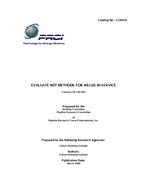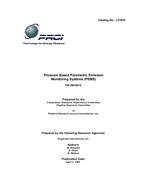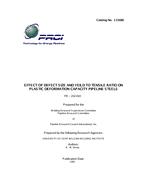Provide PDF Format
PRCI PR-185-924
- Evaluate NDT Methods for Welds In Service
- Report / Survey by Pipeline Research Council International, 03/13/1990
- Publisher: PRCI
$75.00$150.00
L51641e
Edison Welding Institute
Need: The inspection of welds made onto in-service pipelines, which are made primarily for attaching branch connections and repair sleeves, has been the subject of much concern in recent years. The difficulties associated with the inspection of these welds have long been recognized and, historically, the amount of inspection given to such welds has been small. The inspection of welds joining various appurtenances to pipelines is hampered for a number of reasons. The joint geometries can vary considerably, but none of them are particularly suited to detailed inspection. Surface techniques, such as magnetic particle and liquid-penetrant testing, rely on the flaws being at or near the surface, and this is not necessarily the case with the welds of concern. Radiography is difficult since it is not possible to place a radiation source within the pipeline. Ultrasonic inspection is, therefore, the only option if a full volumetric inspection is required. This is made difficult by the inherent complex geometries, and limited access to many of the welds. Welding on pipelines containing flowing, pressurized products results in very rapid cooling of the weld metal and heat-affected-zone regions, significantly increasing the risk of cracking. The use of high hydrogen consumables (specifically EXX10 SMAW electrodes) adds considerably to the risk The probability of discontinuities forming during welding on in-service pipelines is therefore considerably greater than for pipelines that do not contain flowing products.
Benefit: The goal of the present work was to evaluate existing techniques, and to develop and verify improved methodsfor inspection of such welds. In the first phase of this program, welded assemblies that contain realistic examples of discontinuities that occur in practice were produced In the second phase, the reliability of existing nondestructive testing methods were evaluated along with the reliability of novel nondestructive testing systems. The overall objectives of these first two phases were to evaluate the accuracy and reliability of nondestructive testing methods currently applied to welds made onto in-service pipelines, and to assess the improvement possible with methods that are more advanced, but so far have had limited application to these welds. The objective for the Phase III continuation of this project is to demonstrate the accuracy and reliability of nondestructive testing methods using procedures that are optimized based on the knowledge acquired in the first two phases.
Result: The results of this project will show the capabilities and limitations of these methods and will allow a pipeline operator to choose the most reliable method for a particular application. A report that contains guidelines for performing these inspections and describes the capabilities and limitations of the various methods was written.
Edison Welding Institute
Need: The inspection of welds made onto in-service pipelines, which are made primarily for attaching branch connections and repair sleeves, has been the subject of much concern in recent years. The difficulties associated with the inspection of these welds have long been recognized and, historically, the amount of inspection given to such welds has been small. The inspection of welds joining various appurtenances to pipelines is hampered for a number of reasons. The joint geometries can vary considerably, but none of them are particularly suited to detailed inspection. Surface techniques, such as magnetic particle and liquid-penetrant testing, rely on the flaws being at or near the surface, and this is not necessarily the case with the welds of concern. Radiography is difficult since it is not possible to place a radiation source within the pipeline. Ultrasonic inspection is, therefore, the only option if a full volumetric inspection is required. This is made difficult by the inherent complex geometries, and limited access to many of the welds. Welding on pipelines containing flowing, pressurized products results in very rapid cooling of the weld metal and heat-affected-zone regions, significantly increasing the risk of cracking. The use of high hydrogen consumables (specifically EXX10 SMAW electrodes) adds considerably to the risk The probability of discontinuities forming during welding on in-service pipelines is therefore considerably greater than for pipelines that do not contain flowing products.
Benefit: The goal of the present work was to evaluate existing techniques, and to develop and verify improved methodsfor inspection of such welds. In the first phase of this program, welded assemblies that contain realistic examples of discontinuities that occur in practice were produced In the second phase, the reliability of existing nondestructive testing methods were evaluated along with the reliability of novel nondestructive testing systems. The overall objectives of these first two phases were to evaluate the accuracy and reliability of nondestructive testing methods currently applied to welds made onto in-service pipelines, and to assess the improvement possible with methods that are more advanced, but so far have had limited application to these welds. The objective for the Phase III continuation of this project is to demonstrate the accuracy and reliability of nondestructive testing methods using procedures that are optimized based on the knowledge acquired in the first two phases.
Result: The results of this project will show the capabilities and limitations of these methods and will allow a pipeline operator to choose the most reliable method for a particular application. A report that contains guidelines for performing these inspections and describes the capabilities and limitations of the various methods was written.
Related Products
PRCI PR-202-010
Effect of Defect Size and Yield to Tensile Ratio on Plastic Deformation Capacity Pipeline Steels..
$448.00 $895.00
PRCI PR-133-103
Survey and Analysis of Flue Gas Treatment Methods. Volume 2: Selective Catalytic Reduction of Nitro..
$6.00 $12.00





